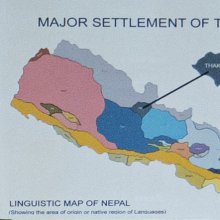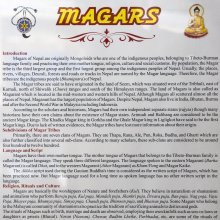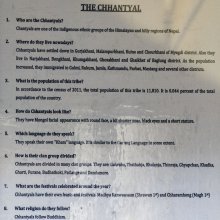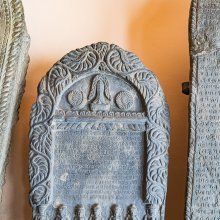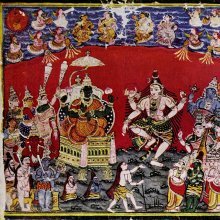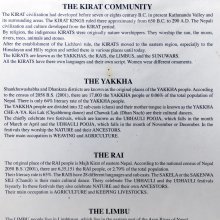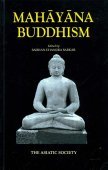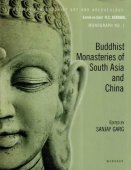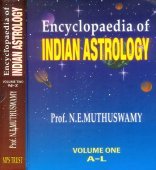Language: 2 definitions
Introduction:
Language means something in Hinduism, Sanskrit, the history of ancient India. If you want to know the exact meaning, history, etymology or English translation of this term then check out the descriptions on this page. Add your comment or reference to a book if you want to contribute to this summary article.
Images (photo gallery)
(+54 more images available)
In Hinduism
Purana and Itihasa (epic history)
Source: Shodhganga: Elements of Art and Architecture in the Trtiyakhanda of the VisnudharmottarapuranaLanguage of Foreigners (in Sanskrit: Mlecchita) were commonly studied, as part of the “sixty four kinds of Art”, according to the Kamasutra of Vatsyayana.—Cf the Sanskrit Mlecchitavikalpa, which refers to the “art of speaking of a new language, though indistinctly, as an option of communication”.—Indian tradition, basically includes sixty four Art forms are acknowledged. The history of Indian Art covers approximately five thousand years which presents a rich and almost continuous record. The references of sixty four kinds of Kala (कला, kalā) are found in the Bhagavatapurana, Shaiva-Tantras, Kamasutra of Vatsyayana etc.

The Purana (पुराण, purāṇas) refers to Sanskrit literature preserving ancient India’s vast cultural history, including historical legends, religious ceremonies, various arts and sciences. The eighteen mahapuranas total over 400,000 shlokas (metrical couplets) and date to at least several centuries BCE.
India history and geography
Source: Singhi Jain Series: Ratnaprabha-suri’s Kuvalayamala-katha (history)Language in ancient India were classified in to four main groups (i.e., Sanskrit, Prakrit, Apabhramsha and Paishachi), according to the 8th-century Kuvalayamālā written by Uddyotanasūri, a Prakrit Campū (similar to Kāvya poetry) narrating the love-story between Prince Candrāpīḍa and the Apsaras Kādambarī.—There is a mention of four major languages, namely, Sanskrit, Prakrit, Apabhramsha and Paishachi; and during the 8th century, vast body of Apabhramsha literature appears to have been already produced. The Paishachi language seems to have been represented by the Bṛhatkathā which had survived in its original form upto the time of Uddyotanasūri. This appears to be very probable since the original Paiśācī Bṛhatkathā was known to Kṣemendra who based his Sanskrit version on it.

The history of India traces the identification of countries, villages, towns and other regions of India, as well as mythology, zoology, royal dynasties, rulers, tribes, local festivities and traditions and regional languages. Ancient India enjoyed religious freedom and encourages the path of Dharma, a concept common to Buddhism, Hinduism, and Jainism.
See also (Relevant definitions)
Ends with: Arabic language, Foreign language, Ritual language.
Full-text (+68267): Samskrita, Java, Jaya, Guda, Kaccha, Aha, Accha, Bhanda, Kana, Kattha, Gahaṇa, Majja, Pautta, Tamil, Ukkosa, Pakkhoda, Atta, Joa, Desia, Pariaddhaa.
Relevant text
Search found 390 books and stories containing Language; (plurals include: Languages). You can also click to the full overview containing English textual excerpts. Below are direct links for the most relevant articles:
Language Policy for India < [April 1962]
On Some Characteristics of Language < [July – September, 1981]
Love Thy Language But don’t hate other Languages < [October – December, 1978]
Philosophy of language in the Five Nikayas (by K.T.S. Sarao)
6. Linguistic Relativity Hypothesis < [Chapter 5 - Language and Thought]
3. On Language (1): Definitions < [Chapter 2 - Concept of Philosophy of Language]
4.3. Faculty of Language < [Chapter 2 - Concept of Philosophy of Language]
Puranic encyclopaedia (by Vettam Mani)
Jarasandhavadha Mahakavyam (by Pankaj L. Jani)
Part 1 - The Art of Translation < [Critical Introduction]
Part 2 - Translation of a Sanskrit Text < [Critical Introduction]
Kavyamimamsa of Rajasekhara (Study) (by Debabrata Barai)
Part 8 - Rājaśekhara and Prākṛita Language < [Chapter 1 - Introduction]
Part 4.1 - Nature and divisions of Vākya (literary speech) < [Chapter 5 - Analyasis and Interpretations of the Kāvyamīmāṃsā]
Part 5.4 - Poetic confidence and Self-consciousness of Kavi (poet) < [Chapter 5 - Analyasis and Interpretations of the Kāvyamīmāṃsā]
Bhishma Charitra (by Kartik Pandya)
Related products
(+25 more products available)
